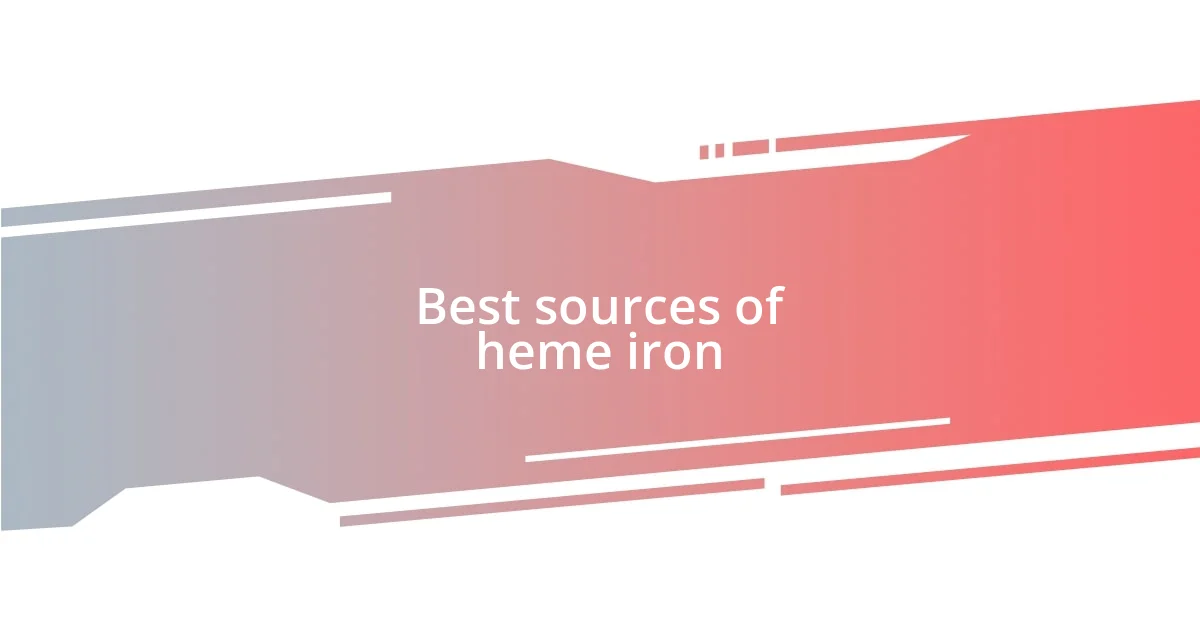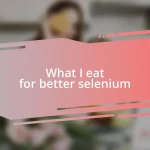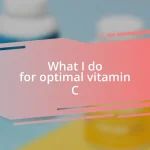Key takeaways:
- Iron-rich foods are vital for maintaining energy levels, immune function, and cognitive health, with individual needs varying based on lifestyle and factors like age and gender.
- There are two types of iron: heme (from animal sources) which is easily absorbed, and non-heme (from plant sources) which can be enhanced by pairing with vitamin C-rich foods.
- Monitoring iron intake through meal journaling, apps, and regular blood tests can help manage and improve dietary habits and overall health.

Understanding iron-rich foods
Iron-rich foods are essential because they help maintain healthy blood and support overall well-being. I remember a time when I felt constantly fatigued, and it turned out my iron levels were low. It made me appreciate how crucial it is to focus on these foods, especially if you lead an active lifestyle.
You might wonder, what exactly qualifies as iron-rich? Foods like red meat, beans, lentils, and dark leafy greens like spinach are fantastic sources. I’ve discovered that incorporating a variety of these foods into my meals not only boosts my iron intake but also adds a vibrant mix of flavors to my plate!
Interestingly, the type of iron in foods matters too. There are two forms: heme iron, found in animal products, and non-heme iron, found in plant-based foods. Personally, I’ve found it helpful to pair non-heme sources, like lentils, with vitamin C-rich foods—like bell peppers or citrus fruits—to enhance absorption. Have you ever tried experimenting with these combinations in your meals? It can truly transform the taste and nutritional value!

Importance of iron in diet
Iron is not just another nutrient; it plays a vital role in transporting oxygen in the blood. Without adequate iron, you could experience fatigue and weakness, making even simple tasks feel daunting. I recall a period when I neglected my iron intake, and my daily energy levels took a sharp dive—I felt like I was constantly running on empty.
Furthermore, iron supports immune function and brain health, which are often overlooked. I vividly remember learning about these benefits during a nutrition class; it opened my eyes to how interconnected our body’s systems are. When I started prioritizing iron in my meals, I not only felt more energetic but also sharper mentally. It’s fascinating how one nutrient can impact so many aspects of our health.
Lastly, it’s crucial to consider our individual needs for iron, which can vary based on factors like age, gender, and activity level. For instance, during my athletic phase, I found myself needing more iron to keep up with increased demands on my body. Reflecting on these experiences makes me realize that being mindful of iron is essential for everyone—not just those with dietary restrictions.
| Function | Impact of Iron |
|---|---|
| Oxygen Transport | Critical for energy levels and overall stamina |
| Immune Function | Enhances the body’s ability to fight off illness |
| Brain Health | Aids in cognitive functions and mental clarity |

Best sources of heme iron
When it comes to heme iron sources, I can’t help but think about how satisfying a hearty steak or a juicy piece of chicken can be. Heme iron, which is highly bioavailable, means our bodies can absorb it more easily. One dinner that stays in my mind involved a grilled lamb chop; not only was it delicious, but knowing it was rich in heme iron made it feel indulgent and nourishing at the same time.
Here are some of the best sources of heme iron you might want to consider incorporating into your diet:
- Red meat (beef, lamb, pork)
- Poultry (chicken, turkey)
- Fish (salmon, tuna, sardines)
- Organ meats (liver, heart)
Just the thought of these foods reminds me of the sizzling sounds and mouthwatering aromas that fill the kitchen when I cook them. It’s not just about the flavors; it’s about giving my body the iron it craves.

Top sources of non-heme iron
When it comes to non-heme iron, my mind immediately turns to plant-based foods that offer a wealth of nutrients. For instance, lentils have been a staple in my meals. I still remember the first time I made a lentil stew; it was hearty and comforting, and knowing that I was loading up on iron made it taste even better. Along with lentils, beans, like chickpeas and black beans, are fantastic sources. Have you ever thrown together a bean salad? It’s simple, nutritious, and incredibly satisfying.
Another noteworthy source is dark leafy greens such as spinach and kale. I often toss a handful of spinach into my morning smoothies or sauté it with garlic for dinner. The vibrant green color always inspires me; it feels like I’m fueling my body with something powerful. These greens pack a punch not just in iron, but they’re also rich in vitamins and minerals. I remember a time when I felt sluggish, and incorporating these greens made a noticeable difference in my energy levels—I was ready to take on the day!
Nuts and seeds also deserve a spotlight in the conversation about non-heme iron. I love snacking on almonds or adding sunflower seeds to my salads. They’re not only crunchy and delicious but also help satisfy my cravings in a nutritious way. Did you know that pumpkin seeds are a great source too? I often sprinkle them on my oatmeal in the morning, marrying flavor with health benefits. Reflecting on how small changes like this made my meals richer in iron, I can’t help but feel that it’s all about finding joy in nutritious food choices. Have you found your favorite non-heme iron sources yet?

Meal planning with iron-rich foods
Meal planning with iron-rich foods can feel like an exciting culinary adventure. When I sit down to plan my meals, I often think about how to incorporate a mix of heme and non-heme sources. For instance, I love creating a weekly rotation that features a hearty beef stew one night and a vibrant chickpea salad the next. It ensures I’m not just consuming iron-rich foods, but also enjoying diverse flavors that make every meal feel special.
I’ve found that adding an iron boost can be as simple as playing with pairings. Just the other day, I cooked a spinach and feta omelet for breakfast, remembering how that combination helps my body absorb the non-heme iron from the spinach. Pairing it with vitamin C-rich fruits, like oranges or strawberries, can elevate the absorption. Have you noticed how a squeeze of lemon over steamed broccoli or a side of berries with your greens can transform the meal? These small tweaks have made meal planning a more enjoyable experience for me.
Let’s not forget snacks—they can be iron-rich too! Whenever I’m craving something crispy, I whip up roasted chickpeas seasoned with my favorite spices; it’s always a hit in my household! Sometimes, I even prepare a batch of trail mix with iron-rich nuts and seeds to keep on hand. This way, I never skip out on nutrition, even on busy days. What quick snacks have you found to keep your iron levels up? Sharing ideas like these not only sparks creativity but also helps us all stay on track with our health goals.

Cooking tips to preserve iron
When it comes to cooking, I’ve discovered that how we prepare our meals can significantly impact the iron content we get. For instance, I learned early on that using cast iron cookware not only enhances the flavor of my dishes but also increases the iron content in them. The first time I made a simple tomato sauce in my cast iron skillet, I was amazed to find that it not only tasted richer but was also a great source of iron. Have you ever noticed the little things you can do in the kitchen that have big effects?
Another tip I embrace is to avoid cooking acidic foods, like tomatoes, in aluminum or non-stick pans for long periods. I remember one time trying to whip up a quick tomato and spinach pasta, and by the end, not only did the flavor suffer, but I later found out that the acidity can leach metals from certain cookware. Instead, I always opt for stainless steel or glass for those recipes. It’s amazing how something as simple as choosing the right pot can preserve the nutrients in our food!
Lastly, I find that cooking times matter too. Keeping vegetables like spinach or kale steamed just until they’re vibrant but still crisp helps maintain their iron content. The first time I overcooked broccoli, it turned a dull green and lost its fresh appeal. Now, I prefer to cook things quickly, so they not only look appetizing but also keep all those valuable nutrients intact. What’s your go-to method for ensuring your veggies shine in both nutrition and flavor?

Monitoring iron intake effectively
Monitoring my iron intake has become a deliberate practice, and I’ve found that keeping a food journal is incredibly useful. Every week, I jot down my meals and snacks, which not only helps me see how much iron I’m getting but also shows me areas where I can improve. Have you ever done this? It was eye-opening for me to see just how much I relied on certain foods while neglecting others.
Another strategy I’ve adopted is using an app to track my nutritional intake. I remember the first time I plugged in my meals; I was surprised to see how I occasionally fell short of my iron goals, especially when my favorite vegetarian meals dominated my plate. It’s comforting to note that these apps often offer suggestions for iron-rich foods, reminding me to diversify my choices. What’s your experience with using technology to enhance your dietary habits?
I’ve also learned that regular blood tests are essential for monitoring my iron levels, especially when I feel more fatigued than usual. It’s not always easy to face the possibility of deficiencies, but having that data empowers me to make informed decisions about my diet. The moment I discovered my iron levels were low, I charged into the kitchen, ready to experiment with new recipes—and it turned out to be a fruitful adventure. Have you ever felt that surge of motivation after receiving health feedback? It’s incredible how awareness can turn into action, leading to a healthier lifestyle.















